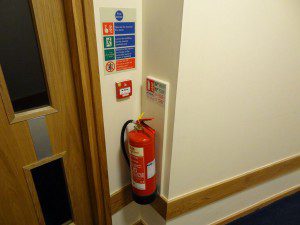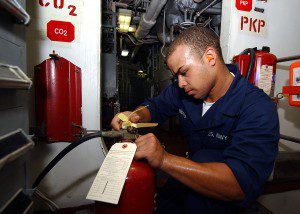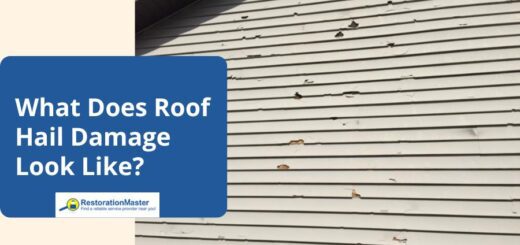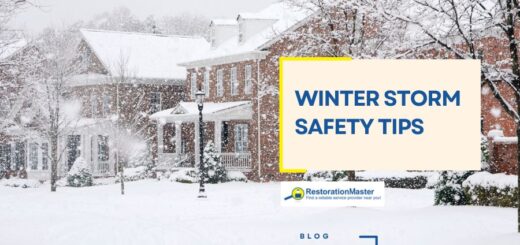Tips for Inspecting Your Fire Extinguisher
Fires are a threat to occur any time in homes and buildings. In many cases, fires start out small and if you have a fire extinguisher handy, you may be able to put the fire out yourself. Putting out small fires as soon as they happen will prevent them from spreading and causing major damage that can cost a lot of money to restore. Stopping a fire right away may also save lives. Fire extinguishers are an effective first defense against fires which makes them a necessity in all homes and buildings.
While many home and businesses owners assume that their fire extinguisher will work when they need it most, there’s a chance it might not. Fire extinguishers are rarely used and if they are not checked and maintained regularly, they will not be functional when they are needed in an emergency. It is up to homeowners and business owners to regularly check their fire extinguishers and provide the necessary maintenanceMaintenance is the routine care, inspection, and repair of a... More so that they are ready to go when there is a fire.
This guide includes important tips to help you inspect your fire extinguishers so you can ensure that they get the maintenanceMaintenance is the routine care, inspection, and repair of a... More they need to be ready if an emergency occurs. You can also work with a professional that provides expert inspections for your fire extinguishers and can take care of the necessary maintenanceMaintenance is the routine care, inspection, and repair of a... More.
Types of Fire Extinguishers
Understanding the different classes of fire extinguishers and the types of fires each one puts out will allow you to better protect your home or business. You should be familiar with the different classes of fire extinguishers and consider the type of fire most likely to occur within your home or building so that your property is equipped with the appropriate type of fire extinguisher.
The following are the classes of fire extinguishers:
- Class A: Puts out fires fueled by wood, paper, fabric, and trash.
- Class B: Puts out fires fueled by flammable liquids by inhibiting chain chemical reactions with a dry chemical.
- Class C: Puts out fires fueled by flammable gases by using a dry chemical to inhibit chain chemical reactions.
- Class D: Puts out fires from flammable metals.
- Class K: Puts out fires from cooking oils and animal fats using chemical agents with a cooling effect.
How Often Should Fire Extinguishers Be Inspected?
You should inspect your fire extinguishers each month to keep them functional. Set a monthly alert as a reminder to inspect the fire extinguishers and keep an inspectionInspection is the careful examination and assessment of a pr... More log to ensure that you do not miss a month. You should also take this time to inspect your smoke detectors.
Fire Extinguisher Inspection Tips

When you get a fire extinguisher for your property, read the instructions and user guide for your extinguisher. The user guide may include maintenanceMaintenance is the routine care, inspection, and repair of a... More and requirements specific for your extinguisher as well as instructions on how to mount it to the wall. You should consider any specific requirements for your extinguisher and follow these basic inspectionInspection is the careful examination and assessment of a pr... More tips:
- Ensure accessibility: The first thing you need to do is make sure that all of your fire extinguishers are easily accessible. The last thing you want when a fire occurs is to have difficulty getting to the fire extinguisher. Make sure they are clearly visible and easily accessible in the following areas of your home:
- Near fireplaces
- In the kitchen
- Outdoors near the grill or outdoor kitchen
- In the garage
- Outside rooms with furnaces, HVAC systems, and water heaters
- Review and update inspectionInspection is the careful examination and assessment of a pr... More tag: Every fire extinguisher should have an inspectionInspection is the careful examination and assessment of a pr... More tag that includes the dates of previous inspections as well as notes about the condition of the extinguisher. If your fire extinguisher does not have an inspectionInspection is the careful examination and assessment of a pr... More tag, you can make one out of a small piece of cardboard. You should check the tag before each inspectionInspection is the careful examination and assessment of a pr... More and update it with the date and notes from your inspectionInspection is the careful examination and assessment of a pr... More.
- Check the pressure: The fire extinguisher needs to be charged to operate efficiently. You should check the pressure gauge to ensure that it is charged at the right amount. If your fire extinguisher needs a charge, you should have it serviced by professionals.
- The needle should be in the green zone of the gauge.
- If the fire extinguisher is overcharged, it could explode when used.
- If the extinguisher is undercharged, it may not be strong enough to put out a fire.
- Check the hose and pin: When using a fire extinguisher, you need to pull the pin to release the chemical spray and aim the hose. Check to see that the pin is secured in place to prevent accidental discharge. The pin should also be tied to the extinguisher. Check the hose as well for signs of damage including cracks and check if it is too brittle to bend. If there is a problem with the hose, it must be replaced.
- Check for physical damage: Make sure to check for physical damage including dents, cracks, leakage, and corrosion. Scratches and dents could be signs that the extinguisher was dropped and there could be a slow leak. You should also inspect the nozzle for bugs, dust, grime, or leakage.
- Check expiration date: Fire extinguishers do have an expiration date. You should keep track of the expiration dates of your extinguishers and replace them as soon as they expire. Expired extinguishers may have failed seals or degraded internal hardware that makes them ineffective. The expiration date should be stamped on the cylinder of the extinguisher.
Dealing with Fire Damage
Having a functional fire extinguisher handy will help you put out small fires and prevent widespread damage. However, it may not be easy or possible for you to extinguish some fires and they may cause considerable damage in your home or building. If your property is damaged by fire and smoke, it is important to call a fire damage restoration professional right away. These technicians can effectively restore fire and smoke damage to return your property to its pre-fire state.













